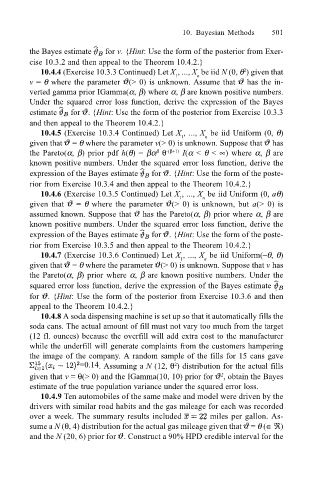Page 524 - Probability and Statistical Inference
P. 524
10. Bayesian Methods 501
the Bayes estimate for v. {Hint: Use the form of the posterior from Exer-
cise 10.3.2 and then appeal to the Theorem 10.4.2.}
2
10.4.4 (Exercise 10.3.3 Continued) Let X , ..., X be iid N (0, θ ) given that
n
1
v = θ where the parameter (> 0) is unknown. Assume that has the in-
verted gamma prior IGamma(α, β) where α, β are known positive numbers.
Under the squared error loss function, derive the expression of the Bayes
estimate for . {Hint: Use the form of the posterior from Exercise 10.3.3
and then appeal to the Theorem 10.4.2.}
10.4.5 (Exercise 10.3.4 Continued) Let X , ..., X be iid Uniform (0, θ)
1 n
given that = θ where the parameter v(> 0) is unknown. Suppose that has
the Pareto(α, β) prior pdf h(θ) = βα θ -(β+1) I(α < θ < ∞) where α, β are
β
known positive numbers. Under the squared error loss function, derive the
expression of the Bayes estimate for . {Hint: Use the form of the poste-
rior from Exercise 10.3.4 and then appeal to the Theorem 10.4.2.}
10.4.6 (Exercise 10.3.5 Continued) Let X , ..., X be iid Uniform (0, aθ)
1
n
given that = θ where the parameter (> 0) is unknown, but a(> 0) is
assumed known. Suppose that has the Pareto(α, β) prior where α, β are
known positive numbers. Under the squared error loss function, derive the
expression of the Bayes estimate for . {Hint: Use the form of the poste-
rior from Exercise 10.3.5 and then appeal to the Theorem 10.4.2.}
10.4.7 (Exercise 10.3.6 Continued) Let X , ..., X be iid Uniform(θ, θ)
1
n
given that = θ where the parameter (> 0) is unknown. Suppose that v has
the Pareto(α, β) prior where α, β are known positive numbers. Under the
squared error loss function, derive the expression of the Bayes estimate
for . {Hint: Use the form of the posterior from Exercise 10.3.6 and then
appeal to the Theorem 10.4.2.}
10.4.8 A soda dispensing machine is set up so that it automatically fills the
soda cans. The actual amount of fill must not vary too much from the target
(12 fl. ounces) because the overfill will add extra cost to the manufacturer
while the underfill will generate complaints from the customers hampering
the image of the company. A random sample of the fills for 15 cans gave
=0.14. Assuming a N (12, θ ) distribution for the actual fills
2
given that v = θ(> 0) and the IGamma(10, 10) prior for 2 , obtain the Bayes
estimate of the true population variance under the squared error loss.
10.4.9 Ten automobiles of the same make and model were driven by the
drivers with similar road habits and the gas mileage for each was recorded
over a week. The summary results included miles per gallon. As-
sume a N (θ, 4) distribution for the actual gas mileage given that = θ (∈ ℜ)
and the N (20, 6) prior for . Construct a 90% HPD credible interval for the

